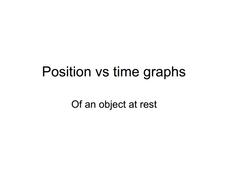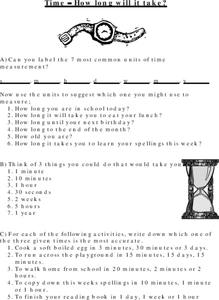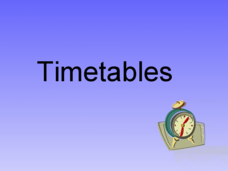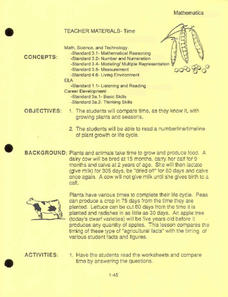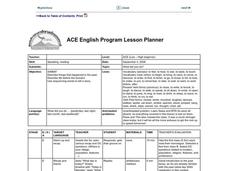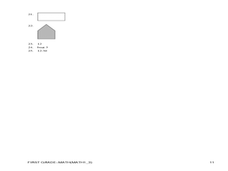Curated OER
Unit II: Worksheet 3 - Velocity
Future engineers analyze the motion of Robin, the roller skater, as he moves along a sidewalk. They graph the position versus time for three different occurrences. Questions are asked about the resulting graphs, reinforcing the concepts...
Curated OER
Position vs. Time Graphs of an Object at Rest
The presentation includes nine time vs. position graphs. The first three are meant to be used for teaching how to read them. The next three provide an opportunity for students to practice reading them, while the last three display the...
Curated OER
Time - How Long Will it Take?
Youngsters think about the length of different periods of time. They label the seven most common units of time measurement, then answer eight questions that have to deal with those same units of time. A good worksheet!
Curated OER
Lesson: From Time to Time
A portrait The Radcliffe Family circa 1742 is inspiration for creative writing and empathetic reasoning. Your class discusses the period in which the piece was painted, then imagines what life was like for one of the people seen in the...
Curated OER
SCHOOLYARD SUNDIAL
Students study the apparent motion of the Sun in the sky over the course of a day and a year, and analyze what causes seasons on Earth. They participate in a project that has both a science as well as an art component.
Curated OER
Real-Life Problems
Choose your operation; scholars read five math-application word problems and determine which of four operations to use in solving each. They work with time and measurements, making sure to include the proper units in their solutions....
Curated OER
Monster Cars: Slope
Learners examine how a rate is calculated from two points. Using battery operated cars, pairs of students measure time and distance. Afterward, they use this data to calculate the rate. Learners then plot four ordered pairs and discover...
Curated OER
Worksheet 3: Graphing Speed and Time
In this graphing speed and time worksheet, learners answer 7 questions regarding graphing, speed, distance, derivatives, Newton's method and wheel radius.
Curated OER
Time
Three time-telling activities help scholars comprehend analog clocks on the hour. First, they write in the time displayed on three clock faces. Beginners to this concept only write in digits, as the o'clock is already written for...
Curated OER
American Flag History
Young historians explore US culture by investigating the US flag. They will use their textbooks, prior knowledge, and sources provided by the teacher to research the history of the American flag. They will design and create a trading...
Curated OER
It's Time to Practice!
Telling time is easy, but if you're learning how to tell time in another language, it can be a tough adjustment! Give your middle and high school beginners this two-page worksheet to review time related vocabulary.
Curated OER
Speed Problems
Return to the classic word problem with these speed scenarios. Learners use some combination of the variables speed, distance, and speed to solve six problems, all of which ask for one of these as an answer. The examples do a nice job of...
Curated OER
Our Solar System - Comparing Planetary Travel Distances
NASA presents a mini-unit on distances in our solar system. It incorporates scientific concepts of gravity, mass, density, and payload while your aspiring astronauts also employ mathematics skills. They calculate speed, they determine...
Curated OER
The Parachute
Students discuss parachutes and write a procedure to determine the effect of different size parachutes and different masses on the time it takes the masses to fall. They record all their data from their experiment then write three...
Curated OER
Acceleration Lab
Young Einsteins experiment with the acceleration of Hot Wheels™ toy cars down inclined planes at various angles. This classic physics lab activity is thoroughly explained in both a teacher’s guide and a student lab sheet. Science...
Curated OER
Timetable Problems
Learning how to read a schedule and determine when you will depart and arrive is an everyday skill that builds competency in chart reading, subtraction, elapsed time, and counting on. Learners discuss how to solve timetable problems and...
Curated OER
Time
An interesting instructional activity focuses the growth cycles of plants and animals. Learners look at plants like radishes, peas, and apples, and compare their growth cycles to those of dairy cows. Some very good worksheets are...
Curated OER
Telling the Time
Introduce the concept of time and all its implications. Kids discover facts about minutes, seconds, days, weeks, months, and years. They label the parts of an analog and digital clock then practice telling the time to the quarter hour.
Curated OER
Half Past Times
Learning how to tell time on an analog clock can be tricky for some kids. Start with the basics and teach them to determine the half-past time. There are five clocks shown. Learners draw in the times indicated, each time is half-past the...
Curated OER
What Did You Do?
English learners practice using the past tense by participating in a time description activity. They identify the differences between verbs when they are used to describe current events or past events. Students answer questions using...
Curated OER
First Grade Math: 1-3
For this first grade math review worksheet, 1st graders answer multiple choice questions about symmetry, money, measurement, time, and more. Students complete 25 questions.
Curated OER
A Dollar Goes A Long Way
Investigate life along the Old Spanish Trail! They visit websites and identify the history and environment. They create journals, dramatic enactments, and maps to discover the role individuals played in society. They also explore the...
Curated OER
Math Cross, Puzzle #26
Here is a measurement, money and time activity which invites learners to solve twenty-eight math problems utilizing addition, subtraction and multiplication strategies to complete a math crossword puzzle.
Curated OER
Time to Cook!
Don't let the cupcakes burn! Using cooking procedure, learners practice drawing minute and hour hands onto five analog clock faces. They read five scenarios which require them to add time increments to find the time required for each...



